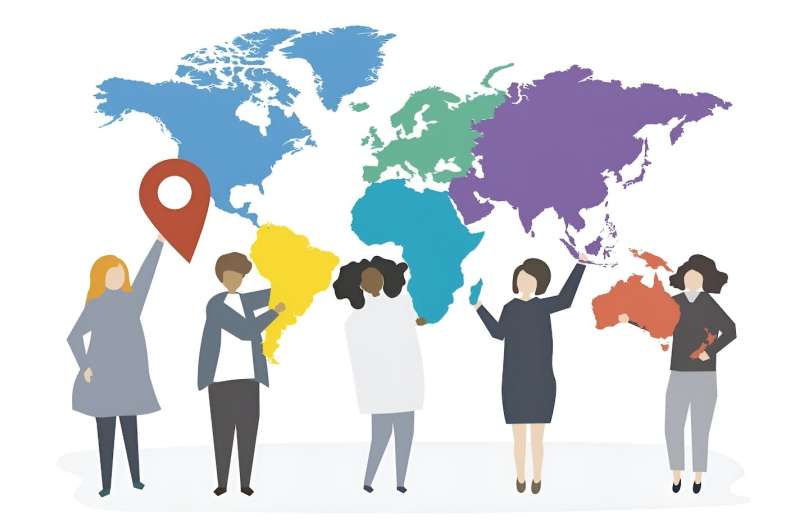This article has been reviewed according to Science X's editorial process and policies. Editors have highlighted the following attributes while ensuring the content's credibility:
fact-checked
trusted source
written by researcher(s)
proofread
Asian women are still a minority in diplomatic positions: How we can fix this?
The 2022 Global Gender Gap Report showed Asian countries have managed to narrow the gender gap in economic, education and health sectors. But when it comes to political participation, the gap persists.
Studies have shown in most Asian countries, women are still marginalized in the field of international relations. They are underrepresented in ambassadorial positions and their low involvement during negotiation processes.
Studies about representation of women in modern diplomacy also assert that in general, Asian women continue to be the minority in this field, with very low percentage.
Despite some progress and efforts to achieve gender parity, Asian women are still in constant conflict with cultural dynamics that hamper their advancement in foreign affairs.
Here's how we fix it.
Women are not represented
As of 2023, the global share of women serving as cabinet ministers globally is just 22.8%, according to the the Inter-Parliamentary Union. Asian countries (Central and Southern Asia) rank the second lowest of the world regions or at 10.1%.
Most of the women (84%) in the cabinet ministers in Asia are assigned in ministries or institutions related to women's issues, gender equality and children. Meanwhile, the number of women serving in traditionally male-dominated fields, such as defense, energy and transportation, remains small—less than 12%.
Globally, out of 193 countries, the portion of women who serve in ministerial positions at the ministries of foreign affairs is only around 20%.
In Asia, the proportion of women as ambassadors and permanent representatives in United Nations (UN) organizations is just 12%, far less than the global average of 20.54%. The Maldives has the greatest ratio of female ambassadors among Asian countries—at 50%, while Cambodia with 25% share is the lowest in Asia.
Right now, only 17 Asian nations that currently have ever had female foreign ministers. In Southeast Asia, it is only Philippines, Timor Leste, Myanmar and Indonesia.
During President Joko "Jokowi" Widodo term, Indonesian female ambassadors made up 13.46% from the total 95 embassies and three permanent missions, that is higher than the previous administration which stood at 9.55%.
The challenges
There are three challenges behind the low representation of women in Asian foreign affairs.
First, the dearth of representation of women in international affairs is inextricably linked to the notion in most Asian nations that males still dominate this field. Historically, diplomacy has been a male-dominated domain with very few provisions for women.
Second, in most Asian countries, there are still unequal cultural and structural power relations inside internal organizations. Patriarchal views and gender preconceptions about the function of female ambassadors still exist.
Third, female diplomats are also affected more disproportionately because they carry double burden in balancing work and personal life.
While they hold public positions, most of them still carry domestic responsibilities. It is still more difficult for women, compared to men, to deal with frequent job rotations, long working hours and placements abroad.
Promoting gender-responsive policies
Research has shown that if women achieved critical mass –somewhere between 20-30%—within an organization they can wield power and influence in public life and the workforce.
But it is not enough to only ensure women receive fair representation in organizations. After achieving critical mass, the next step is to include a gender perspective in foreign policy approaches, formulation and implementation.
In recent years, several governments in Asia have recognized the needs of gender mainstreaming and feminist foreign policy.
Indonesia, for example, has issued a ministerial regulation that facilitates gender-related concerns in ministries, including facilities for female employees.
Other Asian countries are also beginning to implement gender-responsive foreign policy. Several Asian countries have developed National Action Plans on women, peace and security. These include Indonesia (2014), the Philippines (2010 and 2017), South Korea (2014) and Timor Leste (2016).
Sending more female ambassadors to regional and global forums is another way for achieving gender balance and equality.
Efforts have been started but much more is needed. All stakeholders must keep echoing the necessity of gender equality in the work place through better and wider attempts to normalize gender equality in foreign policy institutions.
Provided by The Conversation
This article is republished from The Conversation under a Creative Commons license. Read the original article.![]()





















